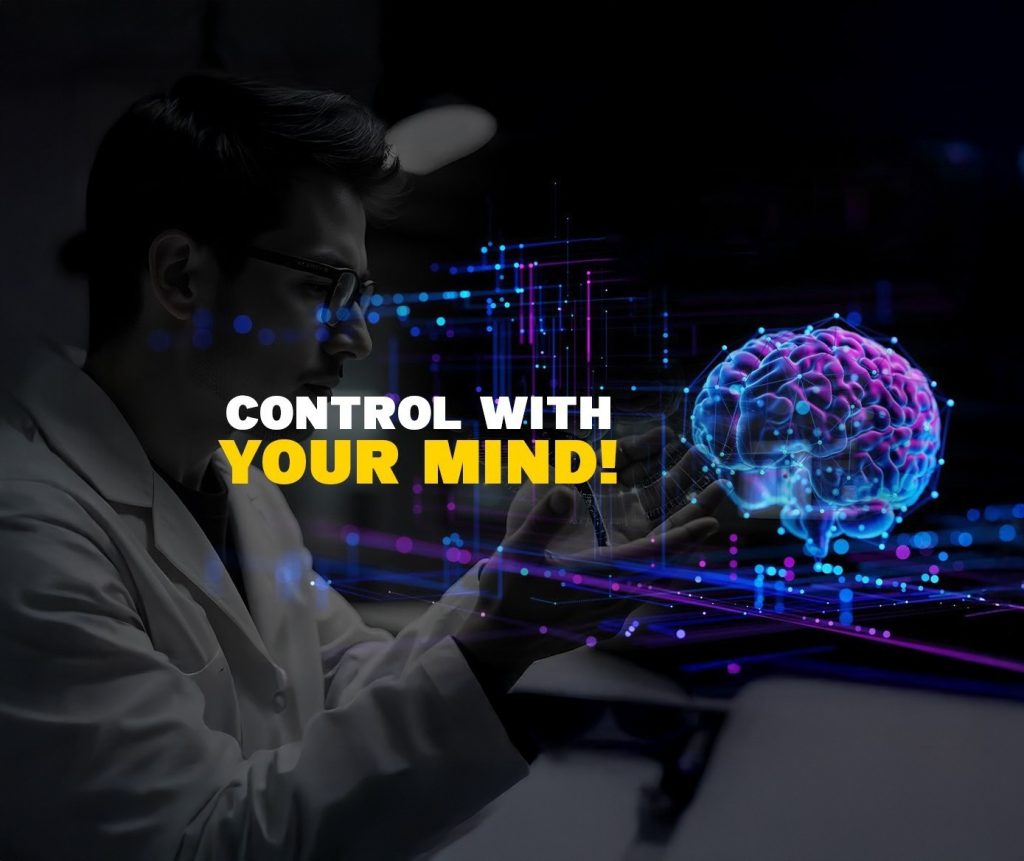Mind Over Machine: Controlling Computers with Your Thoughts Using AI
Imagine surfing the internet, sending messages, or even playing video games—not with your hands, but with your mind.
Welcome to Mind Over Machine, a world where artificial intelligence (AI) and neuroscience converge to let you control devices with your thoughts. Through groundbreaking innovations like Brain-Computer Interfaces (BCIs), mental commands are being transformed into real-time digital actions.
This isn’t science fiction—it’s happening now.
What is a Brain-Computer Interface (BCI)?
A Brain-Computer Interface (BCI) is a sophisticated system that enables direct communication between the human brain and an external device—be it a computer, a robotic limb, or even a smart home system.
Visuals: Brain scans highlighting neural activity, with overlays showing how thoughts are converted into signals.
BCIs work by detecting brain activity, often via sensors placed on the scalp or implanted within the brain. These sensors pick up electrical impulses generated during thoughts, emotions, or movement, and transmit them to an AI system. The AI then decodes these signals into specific commands a machine can understand.
In essence, your thoughts become the mouse, keyboard, or joystick.
How BCIs Work: A Quick Breakdown
- The brain produces electrical impulses.
- Sensors capture these impulses.
- AI processes and translates them.
- Devices respond—hands-free and instantly.
Applications already range from helping people with disabilities regain control of limbs to enabling gamers to play using just their minds.
The Role of AI in Mind-Control Technology
Visuals: Animated brainwaves interfacing with glowing AI networks.
AI is the brain behind decoding the brain. Brain signals are notoriously complex and noisy. That’s where AI—especially deep learning models—steps in to sift through the chaos and identify meaningful patterns.
These models continuously learn from a user’s neural activity, making responses faster and more accurate over time.
This personalized learning is critical for tasks like operating prosthetics or controlling virtual environments, where milliseconds matter.
Applications of AI-Powered BCIs
Visuals: Real-life BCI users, gaming scenes, and assistive tech in action.
- Healthcare: Patients with paralysis can control prosthetics using only their thoughts.
- Gaming: Immersive experiences where your mind becomes the controller.
- Assistive Technology: People with mobility challenges can operate smart home systems independently.
These aren’t just prototypes. They’re real, functional tools enhancing lives today.
Why It Matters: Redefining Accessibility and Empowerment
For individuals who can’t use traditional interfaces, mind-controlled technology is transformative. It offers new ways to communicate, interact, and regain independence.
Visuals: People sharing testimonials about using BCI to regain autonomy.
This is about more than cool gadgets—it’s about human potential.
What’s Next for Mind-Controlled Tech?
Visuals: Futuristic office and home environments controlled by thought.
In the near future, BCIs will become more seamless, integrating with everyday devices. Imagine controlling your phone, sending emails, or even running your smart home without lifting a finger. AI will continue to evolve, making the mind-machine connection faster, more intuitive, and more powerful.
“AI will evolve, making mind-machine interaction faster and more intuitive.”
A Call to Action: Shaping the Future Responsibly
As we push the boundaries of what’s possible, we must do so with caution and care. Ethical development, data privacy, and inclusivity should guide how this technology unfolds.
We’re not just creating smarter tech—we’re reshaping what it means to be human.

Final Thoughts: Unlocking Human Potential
This is not just a revolution in computing—it’s a revolution in capability. Imagine working, playing, and communicating using nothing but your thoughts.
What would YOU do if you could control your tech with just your mind?
If you’re as excited about this future as we are, drop a comment below, share this post, and let’s imagine tomorrow—together.
Share your thoughts in the comments below! Don’t forget to visit our website for more insights on tech trends, AI innovations, and the future of mind over machine.
For further assistance, visit our channel and refer the video
Reinforcement Learning : The Future of AI and Machine Intelligence | Applications & Algorithms

References
- Lebedev, Mikhail A., and Miguel A. Nicolelis. “Brain–Machine Interfaces: From Basic Science to Neuroprostheses and Neurorehabilitation.” Physiological Reviews, vol. 97, no. 2, 2017, pp. 767–837. doi:10.1152/physrev.00027.2016.
- He, Bin, et al. “Brain-Computer Interfaces.” Nature Reviews Neuroscience, vol. 21, no. 12, 2020, pp. 728–741. doi:10.1038/s41583-020-0290-1.
- Rao, Rajesh P.N. Brain-Computer Interfacing: An Introduction. Cambridge University Press, 2013.
- Wolpaw, Jonathan R., and Elizabeth Winter Wolpaw. Brain-Computer Interfaces: Principles and Practice. Oxford University Press, 2012.
Share This :

